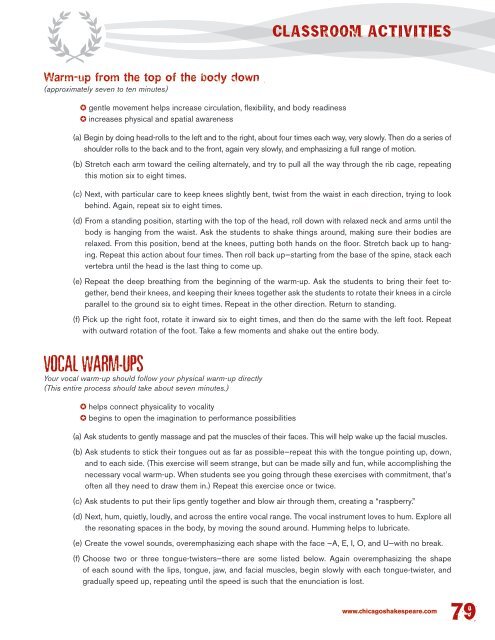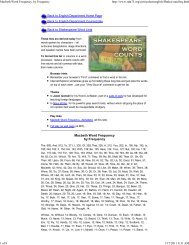Julius Caesar • 2013 - Chicago Shakespeare Theater
Julius Caesar • 2013 - Chicago Shakespeare Theater
Julius Caesar • 2013 - Chicago Shakespeare Theater
Create successful ePaper yourself
Turn your PDF publications into a flip-book with our unique Google optimized e-Paper software.
Warm-up from the top of the body down<br />
(approximately seven to ten minutes)<br />
✪ gentle movement helps increase circulation, flexibility, and body readiness<br />
✪ increases physical and spatial awareness<br />
CLASSROOM ACTIVITIES<br />
(a) Begin by doing head-rolls to the left and to the right, about four times each way, very slowly. Then do a series of<br />
shoulder rolls to the back and to the front, again very slowly, and emphasizing a full range of motion.<br />
(b) Stretch each arm toward the ceiling alternately, and try to pull all the way through the rib cage, repeating<br />
this motion six to eight times.<br />
(c) Next, with particular care to keep knees slightly bent, twist from the waist in each direction, trying to look<br />
behind. Again, repeat six to eight times.<br />
(d) From a standing position, starting with the top of the head, roll down with relaxed neck and arms until the<br />
body is hanging from the waist. Ask the students to shake things around, making sure their bodies are<br />
relaxed. From this position, bend at the knees, putting both hands on the floor. Stretch back up to hanging.<br />
Repeat this action about four times. Then roll back up—starting from the base of the spine, stack each<br />
vertebra until the head is the last thing to come up.<br />
(e) Repeat the deep breathing from the beginning of the warm-up. Ask the students to bring their feet together,<br />
bend their knees, and keeping their knees together ask the students to rotate their knees in a circle<br />
parallel to the ground six to eight times. Repeat in the other direction. Return to standing.<br />
(f) Pick up the right foot, rotate it inward six to eight times, and then do the same with the left foot. Repeat<br />
with outward rotation of the foot. Take a few moments and shake out the entire body.<br />
VOCAL WARM-UPS<br />
Your vocal warm-up should follow your physical warm-up directly<br />
(This entire process should take about seven minutes.)<br />
✪ helps connect physicality to vocality<br />
✪ begins to open the imagination to performance possibilities<br />
(a) Ask students to gently massage and pat the muscles of their faces. This will help wake up the facial muscles.<br />
(b) Ask students to stick their tongues out as far as possible—repeat this with the tongue pointing up, down,<br />
and to each side. (This exercise will seem strange, but can be made silly and fun, while accomplishing the<br />
necessary vocal warm-up. When students see you going through these exercises with commitment, that’s<br />
often all they need to draw them in.) Repeat this exercise once or twice.<br />
(c) Ask students to put their lips gently together and blow air through them, creating a “raspberry.”<br />
(d) Next, hum, quietly, loudly, and across the entire vocal range. The vocal instrument loves to hum. Explore all<br />
the resonating spaces in the body, by moving the sound around. Humming helps to lubricate.<br />
(e) Create the vowel sounds, overemphasizing each shape with the face —A, E, I, O, and U—with no break.<br />
(f) Choose two or three tongue-twisters—there are some listed below. Again overemphasizing the shape<br />
of each sound with the lips, tongue, jaw, and facial muscles, begin slowly with each tongue-twister, and<br />
gradually speed up, repeating until the speed is such that the enunciation is lost.<br />
www chicagoshakespeare com 79




